The Canal de Jonction, linking the Canal du Midi and the Canal de la Robine
The Canal de Jonction was put into service in 1787 to link the Canal du Midi to the Canal de la Robine de Narbonne. It is 5 km long and there are magnificent umbrella pines along a part of the banks, providing shade from the sun. This canal is also included in the UNESCO Canal du Midi World Heritage Site, as is the Canal de la Robine.
The Canal de Jonction - 7 locks over 5 km
The Canal de Jonction branches off from the Canal du Midi at kilometer marker 168.71, in the long canal pound (section with no locks), less than three kilometres from Le Somail, downstream.
It has 7 single locks which allow boats to cross a height difference of 23 metres and for the water to flow gently down towards the Aude river, that boats then need to cross to reach Moussoulens lock, the entrance to the Canal de la Robine on the other side of the river.
The Canal de Jonction is 5.1 km long and includes the following 7 locks:
- Cesse
- Truilhas
- Empare
- Argeliers
- Saint-Cyr
- Sallèles-d’Aude
- Gailhousty.
Just before heading down to the Aude, you'll come to the most monumental engineering structure on the Canal de Jonction, Gailhousty spillway.
Did you know?
Sallèles-d’Aude lock initially had two lock chambers. A dry dock was built next to the lower chamber for boat repair and construction. In the 1980s, when the locks were modified in accordance with the Freycinet gauge to allow 38.50-m-long barges to pass through, the dry dock was removed. Another area was created opposite the Gailhousty spillway building.
Plans for the Canal de Jonction in 1690
Vauban initiated the project
after his work on the Canal de la Robine
Upon recommendation from Vauban, the Canal de la Robine, the former course of the Aude river, was modified to make navigation possible from 1686 and so this created a link between Narbonne and the Canal du Midi, which had opened to navigation two years earlier.
To complete this link, a section between the Canal du Midi and the Aude river needed to be created.
The owners of the Canal du Midi refused the opening of the Canal de Jonction which would need to be supplied with water from the Canal du Midi. Water resources were limited in this region and so they were afraid there wouldn't be enough water to supply both this canal and the Canal du Midi.
It wasn't until the 1770s that a solution was put forward. Meanwhile, goods and passengers were transported either by carts or donkeys between Narbonne and Le Somail, the port of embarkation for the Canal du Midi.
The Canal de Jonction
was finally operational in 1787
In 1776, Monseigneur Arthur-Richard Dillon, archbishop of Narbonne and President of the Estates of Languedoc, finally got the approval from the owners of the Canal du Midi to create the Canal de Jonction. He organised a vote for the funds needed to finalise the project. The work was supervised by Bertrand Garipuy, director of construction work for the Province of Languedoc.
The Canal de Jonction took 10 years to build and was completed in 1787, almost a hundred years after the approval for its construction.

Canal de Jonction à Salléles d'Aude vers Gailhousty © VNF, Collection Sicard
To see in the surrounding area
In the town of Sallèles d’Aude, the Musée Amphoralis is located on the archeological ruins of a Gallo-Roman pottery workshop, proof of the importance of the Narbonne region in industrial and economic activities during Antiquity. The consequential production of amphorae for wine transport is also evidence that vines were already a major crop for the region during this period.
















